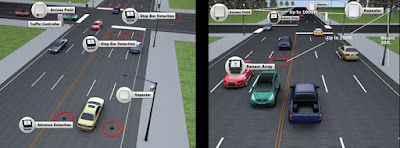DHS, the Dept., of Transportation and probably the DEA are using Bluetooth detectors to spy on motorists and pedestrians.
Government agencies like DHS and the DEA use Bluetooth detectors to gather Bluetooth data from a Wireless Sensor Network.
- Wireless technology that allows electronic devices to communicate directly with one another
- Recently emerged as viable travel time collection technology
- Open standard, allows for off-the-shelf equipment
- Detection range limited to about 328 feet (100 meters)
- Less expensive than many other options
- Flexible installation
- Some potential privacy concerns
- Detection technology relies on drivers’ use of Bluetooth-enabled devices
Bluetooth detectors will soon be able to identify everyone
According to Michael Robertson, “sensors that re-identify vehicles specifically. Some examples given are “electronic toll tag transponders, cell-phone tracking, license plate reading, Bluetooth sniffing, magnetic signatures, (and) video tracking.”
The DOT admits Bluetooth detectors can be used to identify anyone…
If an electronic device were seized by police as evidence, the MAC address could be determined and matched against Bluetooth detection records.
Bluetooth detectors can detect a vehicles speed and location
They can detect a vehicles location, speed and altitude (according to page 25 of the Meshlium datasheet) Bluetooth detectors use a GPS-3G/GPRS realtime tracker.
According to a Delaware DOT Bluetooth brochure, most phones stay discoverable and vehicles with hands-free systems tend to always be discoverable!
How Bluetooth detectors work
According to the DOT, Bluetooth detection systems work by actively searching for in-range Bluetooth devices and capturing the unique media access control (MAC) address of each device. For a Bluetooth detection system to read the MAC address of a device, the device must be turned on and be in “discoverable” mode (i.e., broadcasting its MAC address).Because each device has a unique and permanent MAC address, Bluetooth detection systems can determine vehicle travel times and speeds by calculating the time it takes for vehicles containing Bluetooth devices to travel between two or more Bluetooth sensors that are a known distance apart.
Bluetooth detectors are secretly spying on motorists in National Parks
In other words, the gov’t., wants to secretly spy on every vehicle inside our National Parks.
In-pavement magnetic detectors can identify individual vehicles
According to the DOT, arrays of magnetometers are installed in pavement at detection locations which can identify and match vehicles based on each vehicle’s unique magnetic signature .In-Pavement magnetic detectors also, have close to 100 percent detection rate.
Bluetooth detectors spy on pedestrians
Users have to do nothing to be detected as the WiFi and Bluetooth radios integrated in their Smartphones periodically send a “hello!” message telling about their presence.
Bluetooth detectors spy on entire streets and entire floors of shopping malls
Applications related to shopping and street activities:
- Number of people passing daily in a street
- Average time of the stance of the people in a street
- Differentiate between residents (daily matches) and visitants (sporadic matches)
- Walking routes of people in shopping malls and average time in each area
Source Article from http://feedproxy.google.com/~r/blacklistednews/hKxa/~3/JwLEvsHFY_k/M.html
Related posts:
Views: 0
 RSS Feed
RSS Feed

















 July 22nd, 2016
July 22nd, 2016  Awake Goy
Awake Goy 

 Posted in
Posted in  Tags:
Tags: 
















